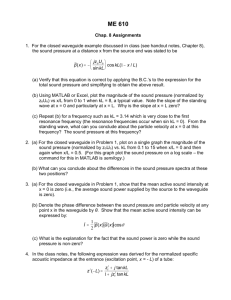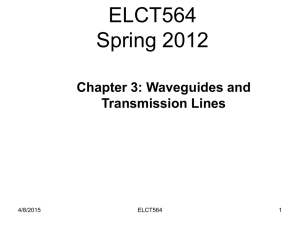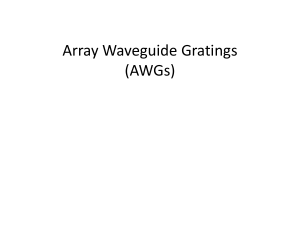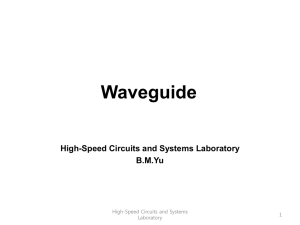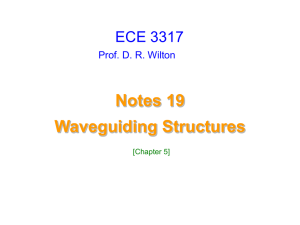Calculation of Heat Transfer Convection Coefficients on All Surfaces
advertisement
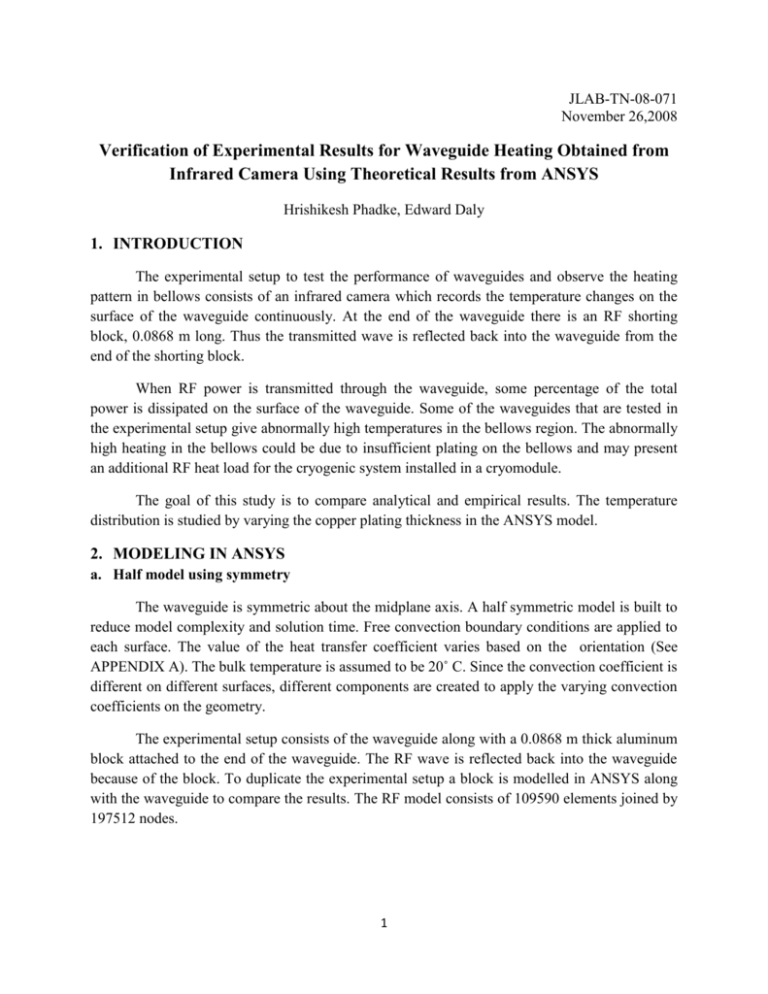
JLAB-TN-08-071
November 26,2008
Verification of Experimental Results for Waveguide Heating Obtained from
Infrared Camera Using Theoretical Results from ANSYS
Hrishikesh Phadke, Edward Daly
1. INTRODUCTION
The experimental setup to test the performance of waveguides and observe the heating
pattern in bellows consists of an infrared camera which records the temperature changes on the
surface of the waveguide continuously. At the end of the waveguide there is an RF shorting
block, 0.0868 m long. Thus the transmitted wave is reflected back into the waveguide from the
end of the shorting block.
When RF power is transmitted through the waveguide, some percentage of the total
power is dissipated on the surface of the waveguide. Some of the waveguides that are tested in
the experimental setup give abnormally high temperatures in the bellows region. The abnormally
high heating in the bellows could be due to insufficient plating on the bellows and may present
an additional RF heat load for the cryogenic system installed in a cryomodule.
The goal of this study is to compare analytical and empirical results. The temperature
distribution is studied by varying the copper plating thickness in the ANSYS model.
2. MODELING IN ANSYS
a. Half model using symmetry
The waveguide is symmetric about the midplane axis. A half symmetric model is built to
reduce model complexity and solution time. Free convection boundary conditions are applied to
each surface. The value of the heat transfer coefficient varies based on the orientation (See
APPENDIX A). The bulk temperature is assumed to be 20˚ C. Since the convection coefficient is
different on different surfaces, different components are created to apply the varying convection
coefficients on the geometry.
The experimental setup consists of the waveguide along with a 0.0868 m thick aluminum
block attached to the end of the waveguide. The RF wave is reflected back into the waveguide
because of the block. To duplicate the experimental setup a block is modelled in ANSYS along
with the waveguide to compare the results. The RF model consists of 109590 elements joined by
197512 nodes.
1
Shorting Block
Waveguide
Bellows
Figure 1: Modeling of Experimental Setup in Ansys
b. Inputs and Boundary Condition for RF Model
The harmonic analysis is done for a frequency of 1.5 Ghz and power of 8000 W in the
waveguide. RF power enters the waveguide at a certain phase angle. The phase angle at which
the RF power enters the waveguide changes the magnetic field pattern and changes the
temperature distribution in the waveguide drastically. Hence different cases have been run by
varying the phase angle from 0 to 180 degrees in increments of 15 degrees. An entry port shown
in Figure 2 below is created through which RF power will enter the waveguide. The other end is
shielded, hence the wave is reflected and will exit through the same port.
2
Entry Port
Symmetry Plane
Figure 2: Electric shielding with resistivity of copper (1.72E-8 Ohm-m) on all surfaces except
entry port and symmetry plane
All the surfaces except the entry port and symmetry plane have electric shielding on them
with the resistivity of copper (1.72E-08 ohm-m). This thickness of the copper plating required by
design is approximately 4.5 microns.
An electric wall is set along all surfaces except the entry port. Thus the magnetic vector potential
in x- direction is set to zero for all the selected surfaces.
3
c. Inputs and Boundary Conditions for Thermal Analysis
The free convection heat transfer coefficient which is calculated (See APPENDIX A) as
function of temperature is applied to the respective surfaces. The model is then solved to obtain
the temperature distribution over the waveguide. The thermal model consists of 49005 elements
joined by 392040 nodes.
Figure 3: Graphical View of Convection Coefficients applied to the Surfaces
Figure 3 shows the heat convection coefficients applied to the different surfaces. Heat
transfer convections coefficient changes with the orientation of the surface, i.e. side, bottom and
top. (See APPENDIX A). Three material models created are related to the orientation of the
surfaces. The red color on the side walls indicates that material model 10. Material model 10
contains the data for convection coefficient on side walls which varies with temperature.
Material model 20 which is shown in blue color contains data for convection coefficient for
bottom surface which also varies with temperature. Material model 30 is also created which
contains data for top surface. The material model is changed from 20 to 30 for doing analysis of
the top surface.
4
3. ANALYTICAL RESULTS
The temperature distribution for 8000 W transmitted power and 4.5 µm copper plating
thickness is shown below for the top and bottom surface of the waveguide.
Figure 4: Peak Temperature on Bottom Surface at Phase Angle of 68 degrees
Figure 5: Peak Temperature on Top Surface at Phase Angle of 68 degrees
5
The peak temperature distribution in a good waveguide for varying phase angles has been
summarized in the Figure 6.
Peak_refltemp vs. Phase_Angle8refl
Peak Temperature on Bottom Surface at Varying Phase Angles
Peak Temperature on Top Surface at Varying Phase Angles
55
Peak Tempertature (Celsius)
50
45
40
35
30
25
20
0
20
40
60
80
100
120
Phase Angle (Degrees)
140
160
180
Figure 6: Peak Temperature variation for Changing Phase Angle
The peak temperature distribution on the top and bottom surface is plotted. It is seen that
the temperature curve for bottom surface runs higher that top surface. The peak temperature is
observed in the bellows at a phase angle of approximately 68 degrees. Further calculations are
done at phase angle of 68 degrees because this matches the temperature pattern most closely.
Also the IR camera takes pictures of the top surface, so analytical results for the top orientations
will be used for comparison.
6
4. COMPARISON OF INFRARED CAMERA AND ANSYS RESULTS ON GOOD
WAVEGUIDE
a. Good Waveguide Comparison
The temperature distribution over the waveguide shows that the peak temperature is
observed in the bellows closer to the small flange end which is similar to the result of infrared
camera. Figure 7 shows the comparison between peak temperatures observed on infrared camera
and using ANSYS results at 68˚ phase angle.
Figure 7: Comparison of Result from Infrared Camera and Ansys for Good Waveguide
Now the next goal of this study is to find out the reason for very high temperature in
certain waveguides which are tested with the infrared camera. The possibility for this high
temperature could be a result of insufficient plating thickness, no plating at all in the bellows, or
improper electrical resistivity of the plated material. So the above parameters are varied one at a
time to find the exact reason for high temperatures in the bellows which are confirming with test
stand results.
7
b. Varying thickness of plating everywhere over the waveguide to study temperature
variation
The first assumption for high temperature is insufficient thickness of copper plating over
the entire region of the waveguide. The thickness of copper plating over the waveguide is varied
from 1 micron to 18 microns to study the effects on temperature variation. It is observed that
plating thickness does not have a significant effect on the temperature. The results are
summarized in Figure 8.
c. Varying thickness of plating only in the bellows to study temperature variation
Since varying the copper plating thickness over the entire waveguide does not have
significant impact on the temperature, it is decided to vary the thickness of copper plating only in
the bellows region, while keeping the copper plating thickness in the remaining regions constant.
The result of temperature variation is summarized in Figure 8.
overy vs. overx
Varying Plating Thickness in Bellows
Varying Plating Thickness Over Entire Waveguide
42
Peak Temperature (Celsius)
41.5
41
40.5
40
39.5
39
38.5
2
4
6
8
10
12
Copper Plating Thickness (Microns)
14
16
Figure 8: Peak Temperature Distribution for Varying Plating Thickness
8
18
d. Varying resistivity of the material from copper to stainless steel to study temperature
variation
The resistivity of the material has a significant effect on the temperature rise in the
waveguide. Due to the complex shape of the bellows, plating in this region can be difficult.
Hence as a result the effective resistivity on the waveguide due to imperfections and uneven
plating can be somewhere between the resistivity of the copper and stainless steel. Hence to
generalize the effect of resistivity on temperature the resistivity is varied from copper (1.57*E-8
ohm-m) to stainless steel (7.72*E-7 ohm-m). Thus it is possible to estimate the overall resistivity
of material in the waveguide from the peak temperature produced in the waveguide.
y vs. x
Peak Temperature change with Varying Resistivity
160
Peak Temperature (Celsius)
140
120
100
80
Copper
Stainless Steel
60
40
1
2
3
4
Resistivity (Ohm-m)
5
6
7
-7
x 10
Figure 9: Peak temperature variation for change in resistivity of material over the entire
waveguide
9
e. Applying electrical resistivity of stainless steel in bellows and copper over the remaining
waveguide
From Figure 8 it is seen that plating thickness of copper does not have significant impact
on the temperature. One more possibility could be the absence of the copper plating in the
bellows region. It is known that the plating process for the bellows is difficult because of its
complex shape. Hence one more case is simulated assuming no copper plating on the bellows
region; instead it would have plating of stainless steel. The results of the simulation are
compared with the results from infrared camera for bad waveguide. The results appear to be
similar indicating a bad waveguide is one which would have no copper plating in the bellow.
Figure 10: Comparison of Result from Infrared Camera and Ansys for Bad Waveguide
10
5. Conclusion
It can be concluded from the results that the main reason for the high temperature in the
bellows is due to no copper plating in the bellow. This is result of the complex shape and the
limitations of the electrolpating method. Hence we should look for effective alternatives to solve
this problem.
6. Future Work
The superconducting linear accelerator have been designed to operate at 2 K. A
significant portion of of the heat load to the 2 K system is supplied by the waveguides for the RF
cavities. Analysis will be done by adding the 2 K and 300 K heat stations at the flanges along
with the 50 K intercept. The impact of heat generated by RF power dissipation through the
waveguides walls on the RF heat load will be determined. Static and dynamic thermal loads and
temperature profiles of the waveguide will be measured. Thus the thermal performance of the
cryomodule waveguide can be evaluated.
11
APPENDIX A 2
Calculation of Heat Transfer Convection Coefficients on All Surfaces of the
Waveguide for Purpose of Analysis
For this geometry the specific form of the corelation depends on whether the plate is
warmer or cooler than the surrounding fluid and on whether it is facing up or down. Hence for
better accuracy it is very important to find out he convection coefficient of the different surfaces
depending on their location i.e. top, bottom and side. The procedure for determing the convection
coefficient of the different surfaces is shown below.
Known: Surface temperature of the waveguide duct.
Find: Heat convection coefficent values for top, bottom and side srfaces.
Schematic:
Ambient air
Tsurr=20˚ C
0.196 m
H=0.02504 m
Ts(Varying with phase angle)
W=0.13442 m
Figure A1: Simplified Diagram of Waveguide
A. Assumptions:
1. Ambient air is quiescent.
2. Surface radiation effects are negligible.
B. Properties:
Table A.4 air (Tf= 300 K ): ν= 15.89 x 10-6 m2/s, α=22.5 x 10-6 m2/s, k= 0.0263 W/m.K,
β= 0.0033 K-1, Pr= 0.707
– F.P. Incropera, D.P. Dewitt, ‘Fundamental of Heat and Mass Tranfer’, 2nd Edition, Wiley, Pg
434
2
12
C. Analysis:
Surface heat loss is by free convection from the vertical sides and the horizontal top and bottom.
RaL = g ∗ β ∗ (T𝑆 −T𝑆𝑢𝑟𝑟 ) ∗
L3
ν∗ α
= (9.8 m/s2)*(0.0033 K-1)*(278.15 K) *(0.025043 m3)/( 15.89 x 10-6 m2/s)*( 22.5 x 10-6 m2/s)
For the two sides, L=H=0.02504 m. hence RaL= 3.99 x 105. The free convection boundary layer
is therefore laminar.
NuL= 0.68 +
0.67∗RaL1/4
4
9 9
0.492 16
[1+(
) ]
Pr
The convection coefficent associated with the sides is then
hs=
𝑘
𝐻
∗ Nu𝐿
𝑊
hs =
0.0263(𝑚∗𝐾)
0.3 𝑚
{0.68 +
hs = 14.3
For top and bottom, L=
𝐴𝑠
𝑃
≈
𝑤
2
1/4
}
4
9 9
0.492 16
[1+(
) ]
0.707
𝑊
𝑚2 ∗𝐾
= 0.067 m. Hence RaL = 2.39 ∗ 107
ht =
𝑘
𝑤
2
𝑊
𝑚∗𝐾
1
3
∗ 0.15 ∗ 𝑅𝑎𝐿
1
0.0263
=
0.67∗3.99∗105
∗ 0.15 ∗ (2.39 ∗ 107 )3
0.067 𝑚
= 11.6
hb =
𝑘
𝑤
2
𝑊
∗𝐾
𝑚2
1
∗ 0.27 ∗ 𝑅𝑎𝐿3
13
hb =
𝑊
𝑚∗𝐾
0.0263
0.067 𝑚
1
∗ 0.27 ∗ (2.39 ∗ 107 )3
hb = 5.065
𝑊
𝑚2 ∗𝐾
The same procedure is followed for different ambient temperature as the surface
temperature is continously changing with change in the phase angle of RF wave.
D. Comments:
These convection coefficients values are put in the ANSYS model to solve for the
temperature distribution in the waveguide.
Temperature Dependent Convection Coefficent on Bottom Surface
Temperature Dependent Convection Coefficient on Side Surfaces
Temperature Dependent Convection Coefficient on Top Surface
16
Convection Coefficient (W/(m 2*K)
14
12
10
8
6
4
300
305
310
315
Average Tempertaure (Kelvin)
320
325
Figure A2: Temperature Dependent convection coefficient values for Bottom, Side and Top
Surfaces
14
Average temperature is assumed to mean of the ambient temperature and surface
temperature. Heat convection coefficients are calculated using average tempertaure. ANSYS also
uses average temperatures for the convection coefficient variation with tempertaure. Thus values
from Figure A2 are put into ANSYS to calculate the temperature distribution in the waveguide.
– F.P. Incropera, D.P. Dewitt, ‘Fundamental of Heat and Mass Tranfer’, 2nd Edition, Wiley, Pg
434
2
15



